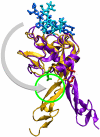For catch bonds, it all hinges on the interdomain region
- PMID: 17000873
- PMCID: PMC2064382
- DOI: 10.1083/jcb.200609029
For catch bonds, it all hinges on the interdomain region
Abstract
Tensile mechanical force was long assumed to increase the detachment rates of biological adhesive bonds (Bell, 1978). However, in the last few years, several receptor-ligand pairs were shown to form "catch bonds," whose lifetimes are enhanced by moderate amounts of force. These include the bacterial adhesive protein FimH binding to its ligand mannose (Thomas et al., 2002; Thomas et al., 2006), blood cell adhesion proteins P- and L-selectin binding to sialyl Lewis X (sLe(X))-containing ligands (Marshall et al., 2003; Evans et al., 2004; Sarangapani et al., 2004), and the myosin-actin motor protein interaction (Guo and Guilford, 2006). The structural mechanism behind this counterintuitive force-enhanced catch bond behavior is of great interest.
Figures

Comment on
-
Flow-enhanced adhesion regulated by a selectin interdomain hinge.J Cell Biol. 2006 Sep 25;174(7):1107-17. doi: 10.1083/jcb.200606056. J Cell Biol. 2006. PMID: 17000883 Free PMC article.

